Creating a lightsaber that is distinctly yours is one of the prerequisites to becoming a great fighter in the Star Wars universe. Star wars lichtschwert A DIY approach was investigated and its designer gave some tips on best practices. This project provides an opportunity to be custom lightsaber creative with an end product, as well as learn the basics of building electronics.
Known as an iconic science fiction weapon, the lightsaber is the brainchild of machinist and Austin, Texas, resident Vince Estacio. It was in 1999 that he first considered designing one. He knew his engineering skills could help him create a saber that he could not buy at the local store – “if you bang a saber hard enough against a surface or against a weapon, the light will go out and it will break” – and he knew he had the knowledge to make one for himself.
Interested in Star Wars and movie props, he searched online forums for inspiration. “We used various filters, films, and superpowers to make it. It was a cooperative effort,” Estacio says. Similarly, I realized that there was nothing out there that gave me complete instructions from beginning to end.
Several years ago, Estacio outlined a step-by-step DIY procedure online after extensive experimentation. It was easier for him to complete the project this time around since the technology and materials have become more readily available and commonplace since he posted his guide. Several retailers now sell prefabricated materials such as the hilt and custom circuit boards that can eliminate the time-consuming task of soldering. For instance, his preferred light source—LEDs—are more widely available.
A DIYer should be able to complete the project in approximately eight hours once they have acquired all the materials (though experienced DIYers might be able to finish it in two). Estacio says a determined ten-year-old (with adult supervision) is capable of doing this.
FIRST STEP
Lightsaber building begins with the most fun step: deciding which color your blade will glow. As a result, you need to be careful when choosing the LED color (there’s a wide range, including blue, red, purple, and green), as each LED color has its own power consumption. Aim for one to three high-power LEDs that are 1 watt each, as well as an optical lens to focus the light.
SECOND STEP
After you’ve selected your sound source, Estacio says that hearing the whoosh and crackle of the saber will make a significant difference in the final product. It is possible to buy parts that simulate the Star Wars sounds from online retailers, or you can buy a retail Lightsaber Custom and take it apart to use its speakers and soundboard, he suggests. For the circuit board that you will wire in with everything else, you can record your own sounds or music.
THIRD STEP
A power source is also needed for your saber. During the early stages of Estacio’s design, he used AA batteries, but they would die after only a few minutes of use — not the kind of battery a Jedi would use. Based on the current and voltage requirements associated with the LED and the number of LEDs you use, he recommends using a 18650 lithium-ion battery the size of a thumb to power the lightsaber for an hour or two. As well as a resistor or BuckPuck, you’ll need something to control the current running through the LED. The LEDs, speakers, and batteries, as well as the switch, are all connected to a circuit board.
Furthermore, the saber’s electronics are housed in the hilt. Alternatively, you can purchase a prefabricated hilt from a retailer such as The Custom Saber Shop or make one yourself from a chrome sink tube (1.5 inches in diameter). Before attaching the blade, ensure that everything fits properly in the hilt and functions properly.
Prevention from shattering
Polycarbonate tubes made of steel prevent shattering, according to Estacio. As well as refraction film for the tube, an end cap must be applied (to prevent the blade from looking hollow). A 40-inch (1-meter) tube is recommended. A series of grooves formed from microscopic ridges are used to capture light when it leaves the tube in this film, explains Estacio. The film is key for the project, and parts can be found at specialty hobby stores. Make sure the film is aligned with the inside of the tube before you roll up the tube.
Each lightsaber project is different due to the material you use and where you get it also classified on the basis of the lightsaber for dueling. Estacio stresses this. Knowing the electronics behind your saber is crucial if you want it to operate in battle, he says.
Practice makes a man perfect
While it might take a while to learn everything, Estacio says Star Wars fans are usually willing to answer questions on the various online forums. Ultimately, he says, “you have to build this by yourself.”. But once you’re done, you will be proud of what you’ve built because it will be unique and yours. Nothing like it will exist anywhere else.”




















